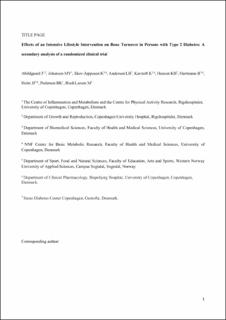| dc.contributor.author | Abildgaard, Julie | |
| dc.contributor.author | Johansen, Mette Yun | |
| dc.contributor.author | Skov-Jeppesen, Kirsa | |
| dc.contributor.author | Andersen, Lars Bo | |
| dc.contributor.author | Karstoft, Kristian | |
| dc.contributor.author | Hansen, Katrine Bagge | |
| dc.contributor.author | Hartmann, Bolette | |
| dc.contributor.author | Holst, Jens Juul | |
| dc.contributor.author | Pedersen, Bente Klarlund | |
| dc.contributor.author | Ried-Larsen, Mathias | |
| dc.date.accessioned | 2022-03-21T12:51:42Z | |
| dc.date.available | 2022-03-21T12:51:42Z | |
| dc.date.created | 2022-01-06T18:48:17Z | |
| dc.date.issued | 2021 | |
| dc.identifier.citation | Abildgaard, J., Johansen, M. Y., Skov-Jeppesen, K., Andersen, L. B., Karstoft, K., Hansen, K. B., Hartmann, B., Holst, J. J., Pedersen, B. K., & Ried-Larsen, M. (2022). Effects of a lifestyle intervention on bone turnover in persons with type 2 diabetes: A post hoc analysis of the U-TURN trial. Medicine & Science in Sports & Exercise, 54(1), 38-46. | en_US |
| dc.identifier.issn | 0195-9131 | |
| dc.identifier.uri | https://hdl.handle.net/11250/2986498 | |
| dc.description | This is an accepted manuscript version of an article published by Lippincott, Williams & Wilkins in Medicine and Science in Sports and Exercise on August 25, 2021, available online: https://doi.org/10.1249/MSS.0000000000002776 | en_US |
| dc.description.abstract | Introduction/Purpose
The increased risk of fractures with type 2 diabetes (T2D) is suggested to be caused by decreased bone turnover. Current international guidelines recommend lifestyle modifications, including exercise, as first-line treatment for T2D. The aim of this study was to investigate the effects of an exercise-based lifestyle intervention on bone turnover and bone mineral density (BMD) in persons with T2D.
Methods
Persons with T2D were randomized to either a 12-month lifestyle intervention (n = 64) or standard care (n = 34). The lifestyle intervention included five to six weekly aerobic training sessions, half of them combined with resistance training. Serum markers of bone turnover (osteocalcin, N-terminal propeptide of type-I procollagen, reflecting bone formation, and carboxyterminal collagen I crosslinks, reflecting bone resorption) and BMD (by DXA) were measured before the intervention and at follow-up.
Results
From baseline to follow-up, s-propeptide of type-I procollagen increased by 34% (95% confidence interval [CI], 17%–50%), serum-carboxyterminal collagen I crosslink by 36% (95% CI, 1%–71%), and s-osteocalcin by 31% (95% CI, 11–51%) more in the lifestyle intervention group compared with standard care. Loss of weight and fat mass were the strongest mediators of the increased bone turnover. Bone mineral density was unaffected by the intervention (ΔBMD, 0.1%; 95% CI, −1.1% to 1.2%).
Conclusions
A 12-month intensive exercise-based lifestyle intervention led to a substantial but balanced increase in bone turnover in persons with T2D. The increased bone turnover combined with a preserved BMD, despite a considerable weight loss, is likely to reflect improved bone health and warrants further studies addressing the impact of exercise on risk of fractures in persons with T2D. | en_US |
| dc.language.iso | eng | en_US |
| dc.publisher | Lippincott, Williams & Wilkins | en_US |
| dc.subject | type 2 diabetes | en_US |
| dc.subject | bone turnover | en_US |
| dc.subject | bone mineral density | en_US |
| dc.subject | exercise | en_US |
| dc.subject | lifestyle intervention | en_US |
| dc.title | Effects of a Lifestyle Intervention on Bone Turnover in Persons with Type 2 Diabetes: A Post Hoc Analysis of the U-TURN Trial | en_US |
| dc.type | Peer reviewed | en_US |
| dc.type | Journal article | en_US |
| dc.description.version | acceptedVersion | en_US |
| dc.subject.nsi | VDP::Medisinske Fag: 700::Klinisk medisinske fag: 750::Endokrinologi: 774 | en_US |
| dc.source.pagenumber | 38-46 | en_US |
| dc.source.volume | 54 | en_US |
| dc.source.journal | Medicine & Science in Sports & Exercise | en_US |
| dc.source.issue | 1 | en_US |
| dc.identifier.doi | 10.1249/MSS.0000000000002776 | |
| dc.identifier.cristin | 1976198 | |
| cristin.ispublished | true | |
| cristin.fulltext | postprint | |
| cristin.qualitycode | 2 | |
